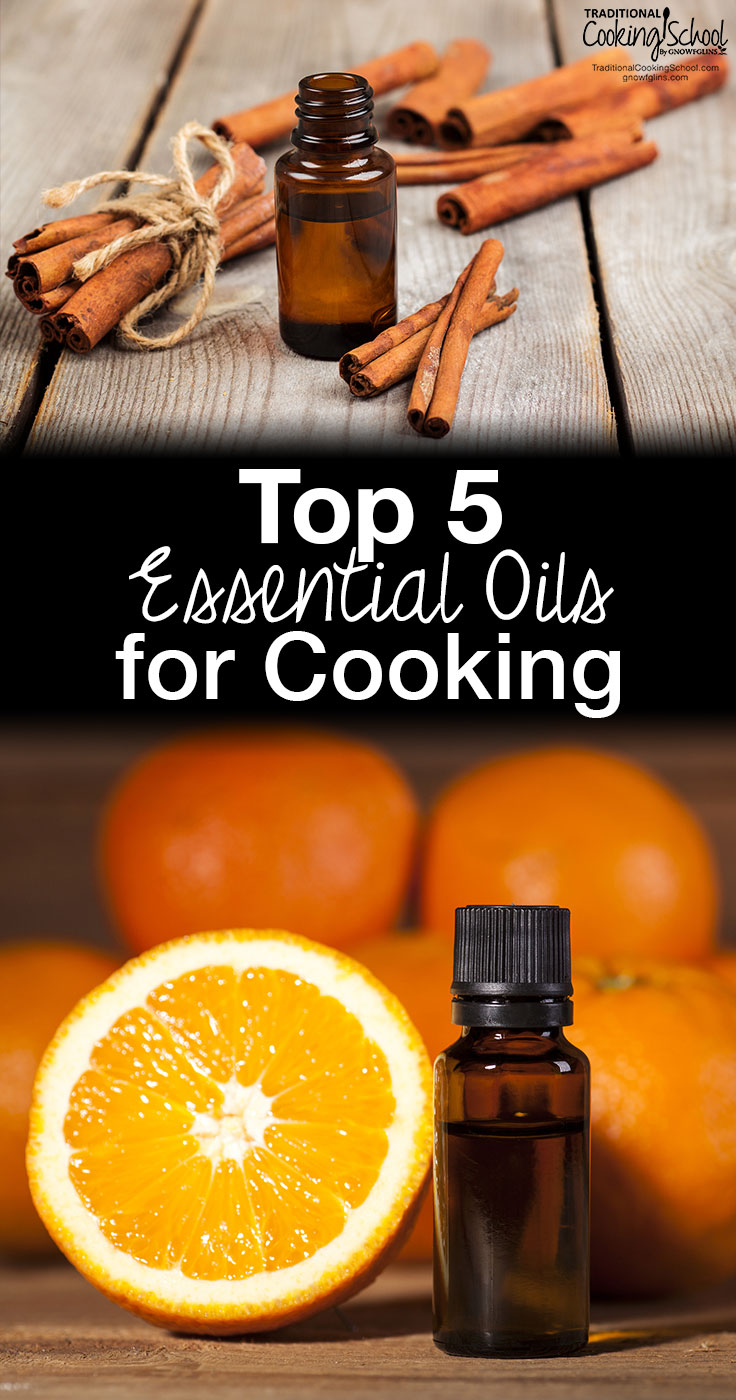

You know you can use essential oils in your diffuser to purify your air.
You know you can use essential oils to fight sickness and boost your immune system.
And you even know how to blend essential oils to make perfume and body butter…
But did you know that you can use essential oils for cooking too?! Add tons of flavor to your raw and cooked recipes with just a drop (or even less!) of an essential oil.
So what oils should you start with? Here are my top 5 essential oils for cooking.
Also… be sure to use high-quality oils, such as the oils from our recommended sources: Rocky Mountain Oils and Aroma Foundry. They’re top-notch and affordable.
Like these these oils, too? Share the infographic image at right on Facebook, Pinterest, or Twitter! Hover over the image and easy share buttons will appear!
#1 — Lemon
By far the most popular of the essential oils for cooking, lemon oil infuses sweet and savory foods with a bright, lemon-y zing. It’s like liquid sunshine!
The flavor is just as good as fresh lemon, though much more concentrated! Lemon essential oil can add digestive and immune-boosting benefits to your uncooked dishes as well (source).
When using fresh lemons, there’s quite a bit of waste left behind: the rind, pith, pulp, and seeds. If that discourages you, take heart because there is no waste with lemon essential oil!
1 bottle of lemon essential oil can last months and possibly be more economical than buying fresh lemons on a weekly basis — especially if at least half of the lemon is going in the wastebasket or compost. Or, if you’re like me and live in a geographical region where fresh lemons are expensive and hard to find, using lemon oil becomes a very frugal, appealing choice.
Lemon essential oil is an excellent choice in any recipe calling for fresh lemon juice, especially raw recipes.
Try lemon essential oil in:
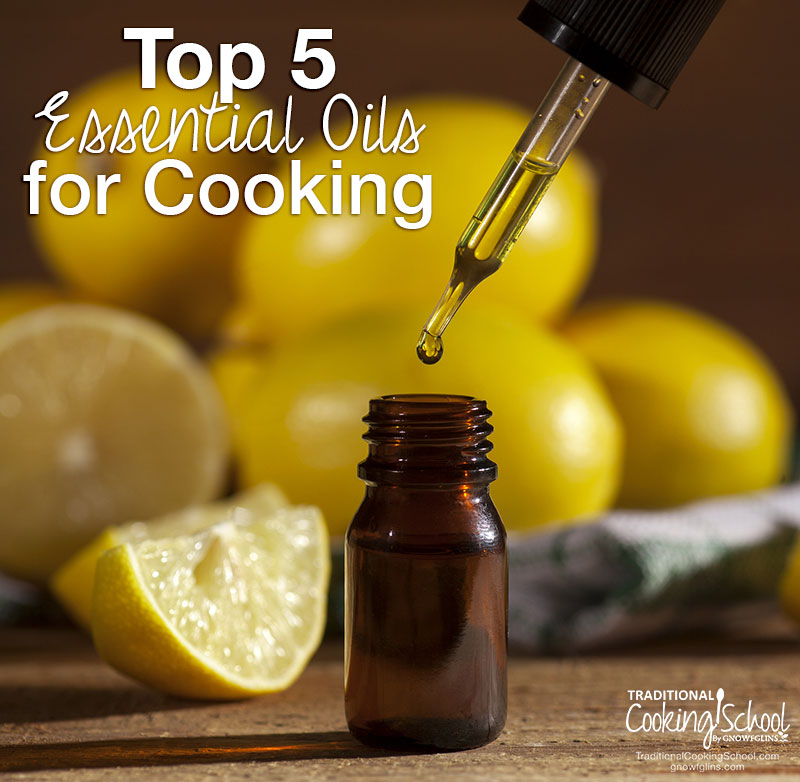
#2 — Peppermint
Did you know that 1 drop of peppermint essential oil is equivalent to 28 cups of peppermint tea?! It’s potent stuff! (Source.)
Like lemon, peppermint essential oil is an excellent digestive aid and can help get rid of an upset stomach within minutes.
The smell and flavor of peppermint essential oil can vary dramatically by brand. I once tried a well-known brand’s peppermint oil in a dessert, and the flavor was like peppermint candy — not herbaceous like peppermint oil is supposed to be.
I made the same recipe again, using my preferred brand of peppermint oil. Guess what? No candy smell or flavor, and the recipe was delicious!
So if you’re going to cook with peppermint oil, make sure you’re investing in a reputable brand such as Rocky Mountain Oils or Aroma Foundry. It should smell and taste like the herb peppermint, not the red and white candy!
Peppermint essential oil is most often used in dessert preparations — especially those with chocolate! Don’t be afraid to experiment with flavors other than chocolate though. Peppermint and citrus make a wonderfully refreshing pairing, too.
Try peppermint essential oil in:
- ice cream (or this one!)
- fudge
- smoothies
- cookies, brownies, and bars
- hot and cold blended coffee drinks
- herbal coffee
And remember! A little goes a LONG way!
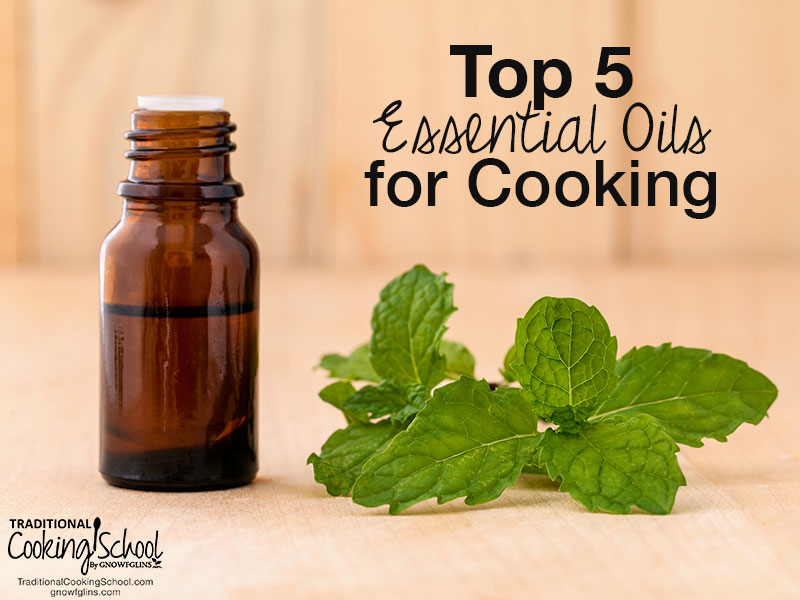
#3 — Basil
There’s nothing on God’s green earth like fresh basil — which is unfortunate, because fresh basil is such a seasonal commodity. 🙁
Once again, an essential oil can remedy that! Basil essential oil!
Basil essential oil contains powerful antioxidants and can improve digestion, reduce water retention, and even kill intestinal parasites (source)! Health benefits aside, basil is also a very economical essential oil. It’s NOT expensive!
For most oils, 1 drop of essential oil = 1 teaspoon of the dried herb or spice. Not so with basil. Basil essential oil is super concentrated. You may only need to dip a toothpick into your oil and stir that tiny amount into your dish to provide the flavor equivalent to a tablespoon of the chopped, fresh herb.
Also, when using basil, thyme, and oregano essential oils in cooking, the flavor tends to get stronger after a day or 2.
What might not taste too basil-y today could be over basil-y in tomorrow’s leftovers. This is why starting with the tiniest amount of basil (or thyme or oregano) essential oil on a toothpick is preferable to adding drops straight from the oil bottle.
You can always add more, but you can’t it take away once it’s in your dish!
Try basil essential oil in:
- Italian dishes like pasta sauces (or pasta salad), meatballs, and lasagna
- salad dressings
- meatloaf
- ice cream and sorbet
- to flavor homemade mayo or hummus
The one recipe basil essential oil won’t work for?
Pesto. 😉
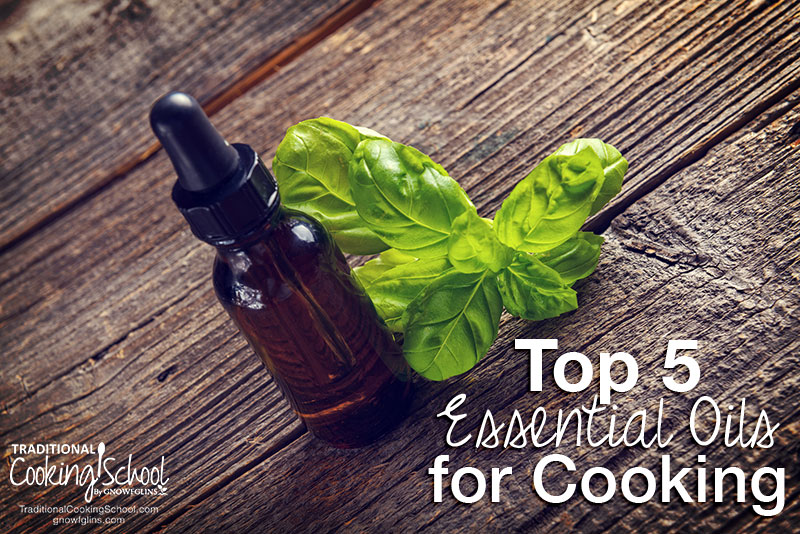
#4 — Orange
Fewer things smell as fresh and energizing as orange essential oil. Cooking with orange essential oil is an excellent way to boost your digestion and immune system.
Orange essential oil is fun because it’s so versatile! It can be used in both sweet and savory preparations.
Using orange essential oil in cooking makes so much sense (and cents!) because you can get more aroma and orange flavor out of 1 or 2 drops of orange essential oil than out of an entire orange + the peel.
If a recipe calls for orange zest and you don’t have a fresh orange, use a drop or 2 of orange essential oil instead.
I eat a low-glycemic diet, so old favorites like Sesame Orange Chicken were out for me since they use sugar and high-glycemic orange juice to make the sticky orange sauce. Yet, I was able to recreate that dish, using stevia instead of sugar and (you guessed it!) orange essential oil instead of orange juice! You can get my recipe here.
Try orange essential oil in:
- anything with chocolate!
- smoothies
- ice cream, sorbet, and gelato
- Asian-inspired dishes
- no-bake treats
- salad dressings
- cookies
- yogurt
- mix with yogurt, sour cream, or cream cheese + a little honey for an orange-flavored fruit dip
- hot or cold tea
- cheesecake
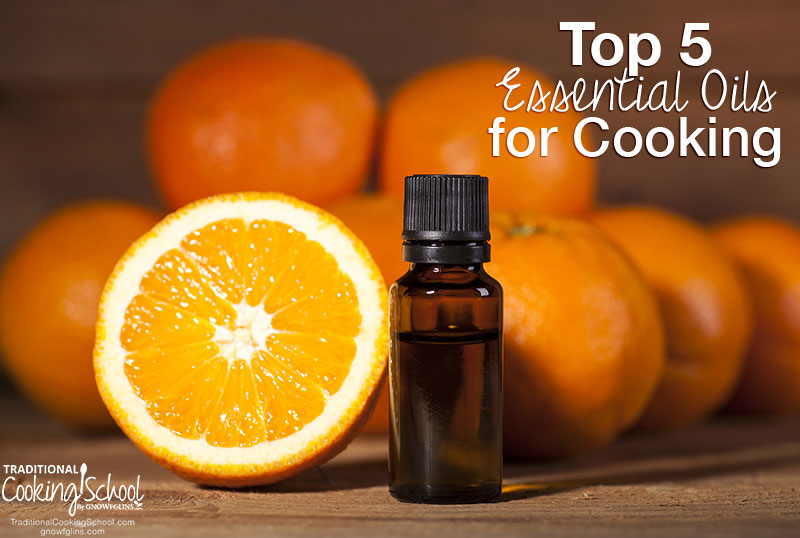
#5 — Cinnamon Bark
Treating urinary tract infections, protecting the kidneys, improving digestive health, and relieving a toothache are just a few of the many potential benefits of cinnamon bark essential oil (source)! And you can reap all these potential benefits by using cinnamon essential oil in your cooking!
We are talking about cinnamon essential oil here, not cinnamon cassia oil, which comes from a different plant and is a cheaper version of cinnamon. There are 2 different types of cinnamon essential oil: cinnamon leaf oil and cinnamon bark oil.
Cinnamon leaf essential oil is steam distilled from the leaves of the cinnamon tree. It is a yellowish color.
Cinnamon bark essential oil comes from the same tree, but is steam distilled from the bark. It is a brownish color with a tint of red. THIS is the essential oil used for cooking.
Be careful with cinnamon bark essential oil. It should never be applied directly to the skin without a carrier because it burns!
This is another oil that you should add to recipes a very teeny amount at a time. Dip a toothpick in cinnamon essential oil and stir into batters or sauces rather than adding drops directly from the bottle.
Cinnamon bark essential oil — like the spice but much more potent — adds a pungent, spicy, warming aroma and flavor to foods.
Used in baking, cinnamon bark essential oil can stand alone or can be combined with other oils like nutmeg and clove.
Try cinnamon bark essential oil in:
- muffins
- quick breads
- cookies
- cakes
- frosting and icing
- apple and pumpkin pies!
- oatmeal
- granola
- pancake or waffle batter
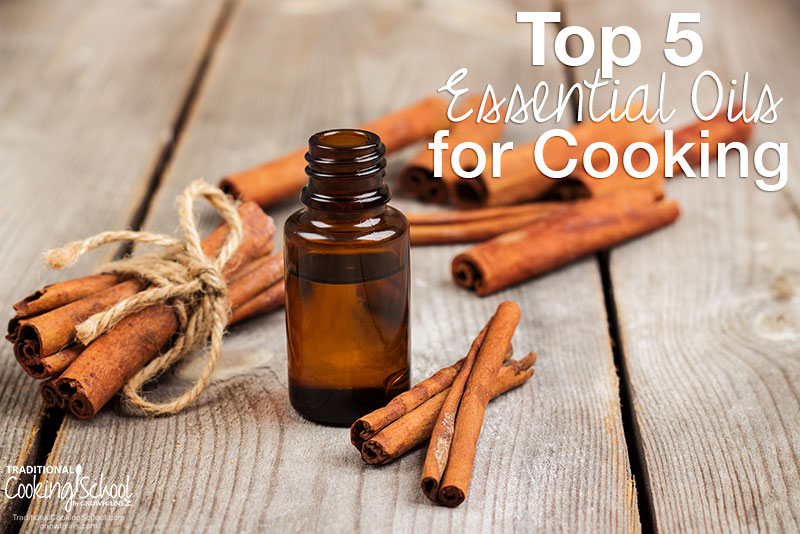
More Essential Oils For Cooking!
These are just my top 5 essential oils for cooking — yet this is by no means an exhaustive list! There are SO many more essential oils for cooking:
- bergamot
- black pepper
- blood orange
- clove
- coriander
- ginger
- grapefruit
- lavender
- lemongrass
- lime
- marjoram
- nutmeg
- oregano
- spearmint
- tangerine
- thyme
- turmeric
- vanilla
For more information about using essential oils in food, check out this book — Aroma: The Magic of Essential Oils in Food and Fragrance.
And remember… always choose high-quality oils, such as the oils from our recommended sources, Rocky Mountain Oils and Aroma Foundry. They’re top-notch and affordable.

Please feel free to share this infographic image on Facebook, Pinterest, or Twitter! Hover over the image and easy share buttons will appear!
Do you use essential oils in cooking? What tips or simple recipes can you share with us?
Disclaimer: At Traditional Cooking School, we recommend using only pure, therapeutic grade essential oils such as those from Rocky Mountain Oils and Aroma Foundry and those generally recognized as safe (GRAS) by the Food and Drug Administration. The information provided by this website is intended for educational and informational purposes only. This post or the essential oils mentioned therein are not intended to diagnose, treat, cure, or prevent any disease. Please consult a qualified aromatherapist when using essential oils for any purpose. If you are pregnant, nursing, taking medication, or have a medical condition, consult your physician before using these products.
We only recommend products and services we wholeheartedly endorse. This post may contain special links through which we earn a small commission if you make a purchase (though your price is the same).


If you used spinach in place of the basil (because it’s too expensive to get fresh basil other than during summer, and even then not always available), could you then use basil essential oil to make the pesto?
I’d run into a recommendation for RMO online & checked out there site. They are not inexpensive & charge for expensive, rare, & valuable oils. Other companies are worse. I love RMO’s comments on sources & uses for their oils.
I am so glad to red your endorsement! I have a list of 13 -20 singles. I avoid blends of oils & meds for the same reasons….unless I blend my choices.
Where exactly is your Grain-free paleo sesame orange chicken recipe using stevia and essential oils instead of orange juice? When I click “get the recipe here,” I see neither essential oils nor stevia in the ingredient list nor in the body of the recipe itself. Step 7 even says to add orange juice and zest!
Hi, Tammy.
Thank you for pointing that out. Lindsey is no longer running Today in Dietzville and it appears the new owners have changed the recipe.
~Danielle, TCS Customer Success Team